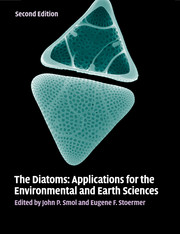Book contents
- Frontmatter
- Contents
- List of contributors
- Preface
- Part I Introduction
- Part II Diatoms as indicators of environmental change in flowing waters and lakes
- 4 Assessing environmental conditions in rivers and streams with diatoms
- 5 Diatoms as indicators of long-term environmental change in rivers, fluvial lakes, and impoundments
- 6 Diatoms as indicators of surface-water acidity
- 7 Diatoms as indicators of lake eutrophication
- 8 Diatoms as indicators of environmental change in shallow lakes
- 9 Diatoms as indicators of water-level change in freshwater lakes
- 10 Diatoms as indicators of hydrologic and climatic change in saline lakes
- 11 Diatoms in ancient lakes
- Part III Diatoms as indicators in Arctic, Antarctic, and alpine lacustrine environments
- Part IV Diatoms as indicators in marine and estuarine environments
- Part V Other applications
- Part VI Conclusions
- Glossary, acronyms, and abbreviations
- Index
- References
8 - Diatoms as indicators of environmental change in shallow lakes
from Part II - Diatoms as indicators of environmental change in flowing waters and lakes
Published online by Cambridge University Press: 05 June 2012
- Frontmatter
- Contents
- List of contributors
- Preface
- Part I Introduction
- Part II Diatoms as indicators of environmental change in flowing waters and lakes
- 4 Assessing environmental conditions in rivers and streams with diatoms
- 5 Diatoms as indicators of long-term environmental change in rivers, fluvial lakes, and impoundments
- 6 Diatoms as indicators of surface-water acidity
- 7 Diatoms as indicators of lake eutrophication
- 8 Diatoms as indicators of environmental change in shallow lakes
- 9 Diatoms as indicators of water-level change in freshwater lakes
- 10 Diatoms as indicators of hydrologic and climatic change in saline lakes
- 11 Diatoms in ancient lakes
- Part III Diatoms as indicators in Arctic, Antarctic, and alpine lacustrine environments
- Part IV Diatoms as indicators in marine and estuarine environments
- Part V Other applications
- Part VI Conclusions
- Glossary, acronyms, and abbreviations
- Index
- References
Summary
Introduction
Historically, limnological and paleolimnological research has focused on large and typically deep lakes but in the last two decades there has been a growing interest in smaller and shallower water bodies. Shallow lakes are justifiably considered as a separate lake type, distinguished physically from deeper waters by the fact that they are permanently mixed (polymictic) with a consequent lack of stratification of temperature or oxygen and with increased potential for nutrient recycling and redistribution of seston by physical water circulation patterns (Carrick et al., 1994). Whilst this is a useful distinction, there is no single definition of a shallow lake (Padisák & Reynolds, 2003). Scheffer (1998), in his classic text book, acknowledged a fundamental difference in the behavior, ecological functioning, and biotic communities of shallow waters and arbitrarily selected a mean depth of less than 3 m to define shallowness. For the purposes of this chapter we have chosen to adopt this definition and thereby to focus on lakes where, under a favorable light climate, benthic algae and/or rooted submerged macrophytes may occupy the majority of the lakebed (see also Jeppesen et al., 1997). Under enriched conditions, however, the mechanisms that stabilize the macrophyte communities of shallow lakes may often break down and a transition to pelagic production with phytoplankton dominance occurs (Scheffer et al., 1993; Vadeboncoeur et al., 2003). Importantly, because of these characteristics, shallow lakes are, for the most part, more vulnerable to a given pollutant load than large lakes.
- Type
- Chapter
- Information
- The DiatomsApplications for the Environmental and Earth Sciences, pp. 152 - 173Publisher: Cambridge University PressPrint publication year: 2010
References
- 36
- Cited by



